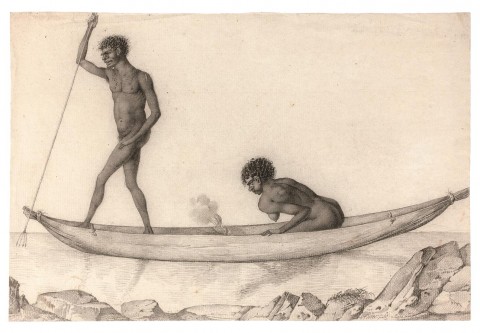(ABORIGINAL MAN AND WOMAN FISHING WITH SPEAR FROM CANOE, WITH FIRE AT CENTRE), June – November 1802
NICOLAS-MARTIN PETIT
pen, ink and graphite on laid paper
watermarked “Budgen 1801”
224 x 333 mm
signed and inscribed lower right: Nicholas petit à Bord Du géographe
None known
A particular study of canoes was a feature of the works of both Petit and Lesueur, but we are not aware of any study that is closely related to the present scene (but refer to the accompanying publication for more commentary on some of the more interesting comparisons held in Le Havre)
A scene of tremendous importance, giving a detailed depiction of a man armed with a fiz-gig standing in the prow of a canoe while a woman tends a fire in the middle of the craft. These canoes were regarded as almost a trademark of Aboriginal life on the waterways of Port Jackson (they can be spotted scattered around on the water in most of the known views, including those done by Baudin’s artists), but it is rare to have such a finely realised study.
Although men and women paddling canoes were not infrequently sketched by the artists, they were never the focus of any of the published plates. In the first edition of Baudin’s voyage two men are seen in a canoe in the background of the Tasmanian scene of plate XIV, for example, and another canoe is prominent in the matching New South Wales scene shown in plate XXIII.
The present sketch must be compared with a similar scene held in Le Havre which also shows a man and a woman in a canoe (B:20025.1), but with the vital proviso that it is evident that the two scenes include different people.
The man in the front of the boat is particularly intriguing, not least because of the obvious similarities with the sketch of the man with a spear (see lot 10). He has the same tightly curled glossy hair, the same prominent nose, and apart from the absence of the smaller vertical scars on the torso, quite similar scarification. If we accept that the headband and the belt were worn for ritual combat and not fishing, the identity becomes even more possible.
However, there are enough differences to the brow, nose, lips and chin as to suggest that it is two individuals, and this is further underlined by the fact that several of the known men, notably Couribarigal and Mosquito, have similar but not identical scarring.
In fact the closest resemblance is with the man on the right in two Petit sketches (B:20045.1 & 20045.2), shown working on a fire. Unfortunately because that man is shown hunched over, his torso is not visible.
The woman in the canoe is more of a mystery, and given that fewer women were drawn then men, a very important inclusion in the scene. Once again identification is rather hampered by the fact that her back is turned to the viewer, and she is shown completely unadorned.
The first edition of Baudin’s voyage (1807) included only one woman from New South Wales, “Oui-ré-kine”, plate XX, noted in pencil on one of Petit’s sketches as “Toulgra’s mère”, while the 1824 second edition added two more, both sadly unnamed, the second holding a young child (“Jeune Femme de la Tribe des Cam-mer-ray-gal”, plate 26 & “Jeune Femme de la Tribu de Bow-row-bi-ron-Gal”, plate 28).
Apart from these three there is also an intriguing finished portrait of a woman named as “Oïe réquiné” (B:20035), which seems to be a secondary phonetic rendering of the above “Oui-ré-kine”, but clearly depicts a different woman; had the two swapped names in some way?
Other than these four major portraits, a woman is also included in a rendering of a second man and woman in a canoe (B:20025.1). Lastly, there is an outline sketch of a woman with child (B:20026) and a woman with child is also at far right of a scene of three men dancing (B:20044.1): it is not proven, but both of these may be additional studies of the woman with child from the tribe of the “Bow-row-bi-ron-gal.”
What this means is that there are only seven other Baudin-era sketches held in Le Havre, depicting perhaps as few as five women from the Sydney region. We have no doubt that the debate about how the present woman fits into this group will be difficult to resolve, but this should only serve as a reminder of the importance of these portraits.
